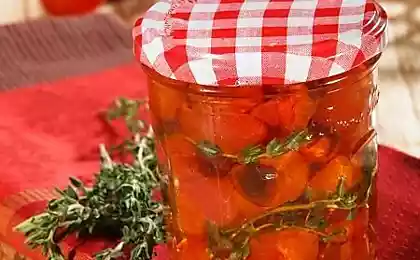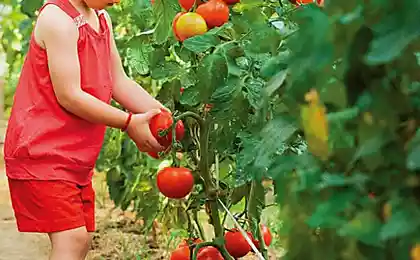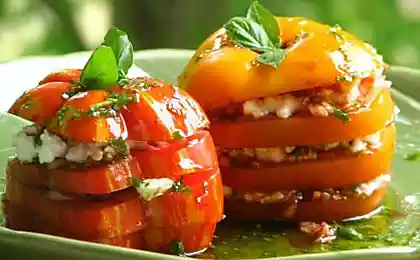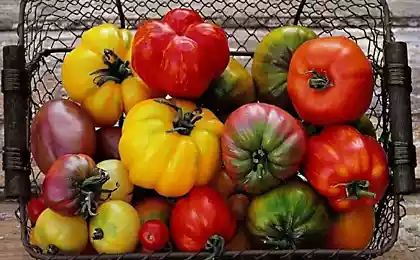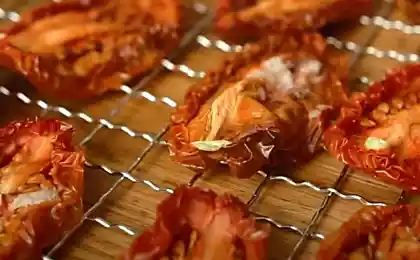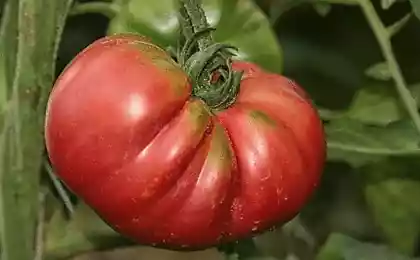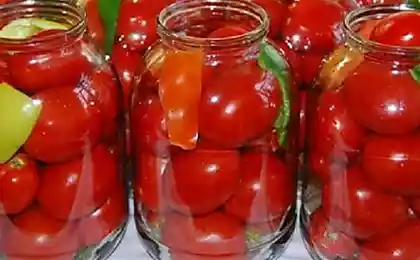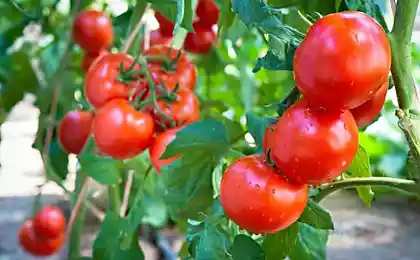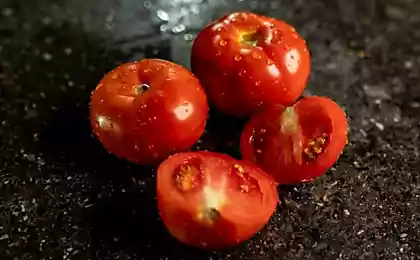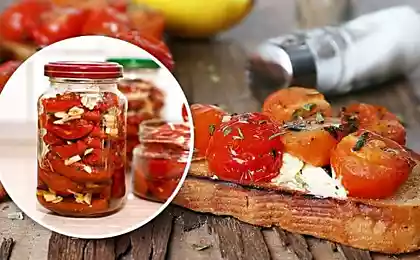648
The secrets of a good harvest of tomatoes
Summer is in full swing, and gardeners every day with anxiety and hope on the Bush tomatoes do well in bloom, how many ties of fruits, healthy... And all I want this year's harvest was certainly better than all the previous.
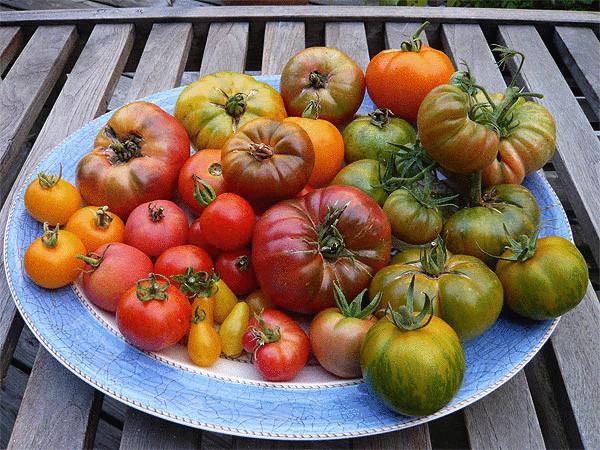
Is it possible to contribute to this? Of course! Especially if you know a few tomato secrets. Most important, today we will share with you.
Secret 1: useful spraying
To increase the yield of tomato bushes, flowering during the second and third floral brushes very well to spray the plants with a weak solution of boric acid. Boron will help germination of pollen, the setting and growth of fruits. Along with this, he is also prostimulirujte the formation of new growth points, and will contribute to the increase of sugar in the fruit. Imagine using this advice, you will be able to increase their yield of tomatoes by 20%!
10 grams of boric acid powder to dissolve in 10 l of water. Enough to spray 1-2 times.
Secret 2: a little shaking
Tomatoes — self-pollinating plants, and in natural conditions they are without any complications pollinated by wind and insects. But the tomatoes grown in greenhouses, was less fortunate: natural factors — wind and flying assistants are absent, and to help pollinate the bushes, "living under a roof" will not be superfluous. Moreover, this process is quite simple. Enough every few days a little shake floral brushes. Experienced gardeners are advised to immediately after shaking all the bushes to spray flowers or to water the soil, and after 1.5-2 hours to ventilate the greenhouse.
Secret 3: tricky geography
If the tomatoes you are growing in a greenhouse, the ideal option would be to place the landing of "latitude" — from East to West. This orientation will provide a more uniform solar lighting all the bushes; they are well warmed by the sun in the morning and have minimal satanarsa neighbor series at noon. As a result, the increase in the length of daylight and increased productivity)
Secret 4: strong roots
No one will not even argue the harder and stronger the roots, the more fruits it can provide food, and the larger these fruits can be. What can we do to "strengthen" the root system of tomato Bush?
At hilling, it turns out, also has its secrets. Spud is necessary at the time of growth of the roots... but the roots of tomatoes do not grow continuously, but periods. It happens like this: first, vigorously growing roots, then they slow its growth, and begins to actively growing vegetative mass. Then the growth of roots aktiviziruyutsya again — until the moment when it starts flowering and fruit set. Once this process has started, the roots again slow its growth.
A time when you have Spud, will prompt the plants themselves. Follow the stem: if the ground it appeared small bumps similar to pimples, — is it the first time, Spud (be sure to wet soil, not dry!). And when the stem near the ground has changed color from green to bluish — he tells you that it's time for the second hilling. If you follow up on this and do everything in a timely manner, the tomato will be able to maximize the root system, thus providing more strength for the harvest!
The benefits of mulching has long been no doubt. Under a protective layer of mulch is not formed soil crust, keeps moisture, do not violate the structure of the soil do not germinate the weeds and not bare roots when watering. Here is the secret: mulch one — and use a lot! Gardeners testify that proper mulching can improve the productivity of Bush... by 25-30%!
What to mulch tomatoes? Hay, straw, compost, sawdust, newsprint, fallen leaves, cut grass, bark, pine needles, peat, and even its leaves. The main thing — to choose the right mulch for their conditions and to properly apply it. The following video Valery Medvedev talks about mulching tomatoes forest land
Secret 5: "their own land" Some experienced gardeners have noticed that tomatoes love to grow... on their tops! If you fall all healthy leaves to collect, crush and seal in the ground next spring it will be the best place for a young tomato seedlings. And if you're still under the roots of the seedlings on the advice of our gardeners dare to put a little fresh fish — crop 50% already secured))
Secret 6: remove side shoots
Side-shoot removing is the removal of superfluous shoots. (All the fairy-tale plot: the stepdaughter into the woods to daughter's more good went). In tomato it just works: the plant ceases use of strength and nutrients on the extra herbs and concentrates only on the "useful activities" — the implementation plan for the harvest.
In the remove side shoots also have their secrets: not all of the stepson to the stalk removed, without at any time doing this and all shrubs equally phasingout:
to stepchildren do not grow again, they are not removed until the stem, but leave a "stub" value of 0.5-1 cm
remove side shoots of tomatoes in open ground can be carried out once for the whole season, and you can do it regularly — at least the appearance of laterals.
In the following video lesson on the correct side-shoot removing interdeterminate and determinate varieties of tomatoes.
Secret 7: remove the leaves Except the pinching, bushes of tomatoes during fruiting pluck the leaves. This is to ensure that all of the power plant gave color and fruit. In addition, lower leaves in contact with the ground, can become a conductor of infection.
Experienced gardeners suggest to cut from the middle (late) June 1-3 lower leaf every week until the first inflorescence. Then the tomatoes will be "ventilated", and the extra load from the bushes removed. How many leaves to remove from the Bush — every cottager decides for himself. There is one rule that will help you navigate: while in brush is not fastened all the fruits on top (above the brush) all the sheets must be "available". Remove the leaves is recommended in dry warm weather, in the morning, so the wound has time to heal and not become a gateway for infection.
The following video introduces us to the system of pruning the leaves of tomatoes grown in the greenhouse. Lesson trimming holds Valery Medvedev (right about the pruning of leaves from 3.41)
Secret 8: foliar feeding If you think foliar feeding is not a particularly important procedure in vain. Just spraying the green parts of tomatoes to solutions of trace elements will help you to get an earlier harvest, and the plant — "more nutritious rations" and protection from disease! The best foliar feeding carried out every 7-9 days in calm weather in the evenings.
What to use for foliar feeding
Secret 9: a dessert for fruit
Some inexperienced gardeners during fruiting strenuously to feed the tomato plants with organic matter and all kinds of fertilizers — "to have enough strength!". Just do not have to. Enhanced fertilizer needed for active growing season, but during the period when the plant enters the fruiting season, we can recommend this power supply:
on damp soil sprinkle under bushes of tomatoes dry ash, 3-4 tablespoons per 1 sq. m. the feeding is even and will give the tomatoes the sweetness. Ash you can place the tomatoes until the end of fruiting every 2 weeks.
Recipe 2: mineral cocktail
2 liter jars of ash to pour 5 liters of boiling water, after cooling, bring the volume to 10 liters + 10 g of boric acid powder + 10 ml of iodine (bottle). Infuse a solution of 1 day. The resulting infusion diluted in 10 times. The rate of feeding — 1 a litre every tree.
In a glass 3-liter jar put 100 g of live yeast + 0.5 cups of sugar. Add defended almost to the top with warm water, put in a warm place for fermentation. Until the end of fermentation to stir occasionally. The resulting "mash" to use for feeding at the rate of 1 Cup per 10 liters of water. Feed it fertilizer once at the rate of 1 liter under a Bush.
Are season after season, and every year brings into the Treasury of the country experience something of their own, previously unknown. Our gardeners are happy to share their secrets and tricks, each of which affects the future crop. The advice of experienced gardeners you will find articles on our website:
Source: www.7dach.ru

Is it possible to contribute to this? Of course! Especially if you know a few tomato secrets. Most important, today we will share with you.
Secret 1: useful spraying
To increase the yield of tomato bushes, flowering during the second and third floral brushes very well to spray the plants with a weak solution of boric acid. Boron will help germination of pollen, the setting and growth of fruits. Along with this, he is also prostimulirujte the formation of new growth points, and will contribute to the increase of sugar in the fruit. Imagine using this advice, you will be able to increase their yield of tomatoes by 20%!
10 grams of boric acid powder to dissolve in 10 l of water. Enough to spray 1-2 times.
Secret 2: a little shaking
Tomatoes — self-pollinating plants, and in natural conditions they are without any complications pollinated by wind and insects. But the tomatoes grown in greenhouses, was less fortunate: natural factors — wind and flying assistants are absent, and to help pollinate the bushes, "living under a roof" will not be superfluous. Moreover, this process is quite simple. Enough every few days a little shake floral brushes. Experienced gardeners are advised to immediately after shaking all the bushes to spray flowers or to water the soil, and after 1.5-2 hours to ventilate the greenhouse.
Secret 3: tricky geography
If the tomatoes you are growing in a greenhouse, the ideal option would be to place the landing of "latitude" — from East to West. This orientation will provide a more uniform solar lighting all the bushes; they are well warmed by the sun in the morning and have minimal satanarsa neighbor series at noon. As a result, the increase in the length of daylight and increased productivity)
Secret 4: strong roots
No one will not even argue the harder and stronger the roots, the more fruits it can provide food, and the larger these fruits can be. What can we do to "strengthen" the root system of tomato Bush?
At hilling, it turns out, also has its secrets. Spud is necessary at the time of growth of the roots... but the roots of tomatoes do not grow continuously, but periods. It happens like this: first, vigorously growing roots, then they slow its growth, and begins to actively growing vegetative mass. Then the growth of roots aktiviziruyutsya again — until the moment when it starts flowering and fruit set. Once this process has started, the roots again slow its growth.
A time when you have Spud, will prompt the plants themselves. Follow the stem: if the ground it appeared small bumps similar to pimples, — is it the first time, Spud (be sure to wet soil, not dry!). And when the stem near the ground has changed color from green to bluish — he tells you that it's time for the second hilling. If you follow up on this and do everything in a timely manner, the tomato will be able to maximize the root system, thus providing more strength for the harvest!
The benefits of mulching has long been no doubt. Under a protective layer of mulch is not formed soil crust, keeps moisture, do not violate the structure of the soil do not germinate the weeds and not bare roots when watering. Here is the secret: mulch one — and use a lot! Gardeners testify that proper mulching can improve the productivity of Bush... by 25-30%!
What to mulch tomatoes? Hay, straw, compost, sawdust, newsprint, fallen leaves, cut grass, bark, pine needles, peat, and even its leaves. The main thing — to choose the right mulch for their conditions and to properly apply it. The following video Valery Medvedev talks about mulching tomatoes forest land
Secret 5: "their own land" Some experienced gardeners have noticed that tomatoes love to grow... on their tops! If you fall all healthy leaves to collect, crush and seal in the ground next spring it will be the best place for a young tomato seedlings. And if you're still under the roots of the seedlings on the advice of our gardeners dare to put a little fresh fish — crop 50% already secured))
Secret 6: remove side shoots
Side-shoot removing is the removal of superfluous shoots. (All the fairy-tale plot: the stepdaughter into the woods to daughter's more good went). In tomato it just works: the plant ceases use of strength and nutrients on the extra herbs and concentrates only on the "useful activities" — the implementation plan for the harvest.
In the remove side shoots also have their secrets: not all of the stepson to the stalk removed, without at any time doing this and all shrubs equally phasingout:
to stepchildren do not grow again, they are not removed until the stem, but leave a "stub" value of 0.5-1 cm
remove side shoots of tomatoes in open ground can be carried out once for the whole season, and you can do it regularly — at least the appearance of laterals.
In the following video lesson on the correct side-shoot removing interdeterminate and determinate varieties of tomatoes.
Secret 7: remove the leaves Except the pinching, bushes of tomatoes during fruiting pluck the leaves. This is to ensure that all of the power plant gave color and fruit. In addition, lower leaves in contact with the ground, can become a conductor of infection.
Experienced gardeners suggest to cut from the middle (late) June 1-3 lower leaf every week until the first inflorescence. Then the tomatoes will be "ventilated", and the extra load from the bushes removed. How many leaves to remove from the Bush — every cottager decides for himself. There is one rule that will help you navigate: while in brush is not fastened all the fruits on top (above the brush) all the sheets must be "available". Remove the leaves is recommended in dry warm weather, in the morning, so the wound has time to heal and not become a gateway for infection.
The following video introduces us to the system of pruning the leaves of tomatoes grown in the greenhouse. Lesson trimming holds Valery Medvedev (right about the pruning of leaves from 3.41)
Secret 8: foliar feeding If you think foliar feeding is not a particularly important procedure in vain. Just spraying the green parts of tomatoes to solutions of trace elements will help you to get an earlier harvest, and the plant — "more nutritious rations" and protection from disease! The best foliar feeding carried out every 7-9 days in calm weather in the evenings.
What to use for foliar feeding
- urea (10 l — 1 teaspoon)
- potassium nitrate or potassium monophosphate (10 l — 1 teaspoon)
- calcium nitrate (10 l — 1 teaspoon)
- 1 l of serum + 20 drops of iodine per 10 liters of water
Secret 9: a dessert for fruit
Some inexperienced gardeners during fruiting strenuously to feed the tomato plants with organic matter and all kinds of fertilizers — "to have enough strength!". Just do not have to. Enhanced fertilizer needed for active growing season, but during the period when the plant enters the fruiting season, we can recommend this power supply:
on damp soil sprinkle under bushes of tomatoes dry ash, 3-4 tablespoons per 1 sq. m. the feeding is even and will give the tomatoes the sweetness. Ash you can place the tomatoes until the end of fruiting every 2 weeks.
Recipe 2: mineral cocktail
2 liter jars of ash to pour 5 liters of boiling water, after cooling, bring the volume to 10 liters + 10 g of boric acid powder + 10 ml of iodine (bottle). Infuse a solution of 1 day. The resulting infusion diluted in 10 times. The rate of feeding — 1 a litre every tree.
In a glass 3-liter jar put 100 g of live yeast + 0.5 cups of sugar. Add defended almost to the top with warm water, put in a warm place for fermentation. Until the end of fermentation to stir occasionally. The resulting "mash" to use for feeding at the rate of 1 Cup per 10 liters of water. Feed it fertilizer once at the rate of 1 liter under a Bush.
Are season after season, and every year brings into the Treasury of the country experience something of their own, previously unknown. Our gardeners are happy to share their secrets and tricks, each of which affects the future crop. The advice of experienced gardeners you will find articles on our website:
Source: www.7dach.ru
Write drunk, edit sober— 8 things,which would have made Ernest Hemingway
What technologies can replace electric cars


